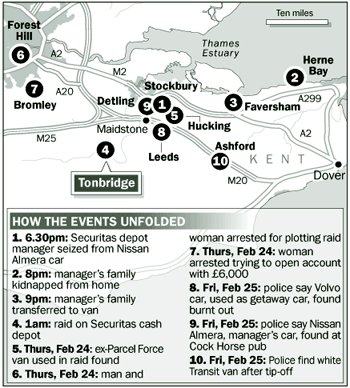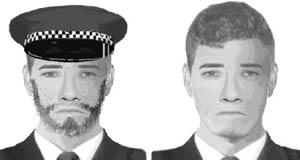HEWITT.MOBI
Saturday, February 25, 2006

The Times February 25, 2006
The Great Tonbridge Robbery
By Ben Macintyre and Stewart Tendler
Steal £50 million and the public will probably think of you as a loveable rogue - but this latest bank heist in fact reveals the true ruthlessness of the criminal mastermind
THE Great Tonbridge Robbery was a heist at once familiar and extraordinary. It was the latest chapter in a tale of cops and robbers that is embedded deep in our cultural heritage, but a crime unlike any before it; a theft tailor-made for the 21st century.
The clichéd language of crime was lying in wait for the gang the moment that the lorry loaded with up to £50 million sped into the Kent night: “Fort Knox”, “military precision”, “The Firm”, “blaggers”, and “armed to the teeth”. Here was a story of masked robbers, brutality and criminal daring, echoing every British heist from the Great Train Robbery to the IRA raid on the Northern Bank in Belfast in 2004.
As if Hollywood had already written the script, the day after the robbery a woman aged 41 was arrested while trying to open a building society account in Bromley, Kent, with £6,000 in cash, the bundles apparently held together with wrappers from the Tonbridge depot. Last night detectives confirmed that some of the missing cash had been found in a Ford Transit van in Ashford after a tip-off.
The stereotypes are piling up around a crime that is far from stereotypical. The crooks may be Biggs-style criminal extroverts, a new version of the Old Firm, or some unnamed criminal mastermind playing the role of Michael Caine. Criminals are just as prone to believing and acting out their own mythology as policemen, footballers or politicians.
In Britain the mythology of bank robbery is indissolubly linked to films such as The Ladykillers and Buster, featuring rogues with hearts of gold and impeccable comic timing, despite the true nature of their nefarious activities.
Two other people in Forest Hill, South London, were arrested on Thursday night on suspicion of conspiracy to commit a robbery, as detectives drew up a list of the usual suspects — the 20 or so criminals believed capable of organising such a sting — and released an e-fit of one of the men, who posed as a police officer. All three suspects were later bailed.
The Volvo used to kidnap Colin Dixon, 51, the manager of the Securitas depot in Tonbridge, was found burnt in the village of Leeds, near Maidstone. Two criminals posing as police in the dark Volvo, a blue light flashing behind its grille, intercepted Mr Dixon as other members of the gang seized his wife and son. Mr Dixon’s Nissan was found parked in the Cock Horse pub at Detling, and a red van used in the abduction was found in another pub car park near Maidstone. The white Renault lorry filmed driving off with the stolen money has still not been located.
Assistant Chief Constable Adrian Leppard did not hide a certain grim admiration for the efficiency of the crooks. “This is organised crime at its top level,” he said. If reaction to the crime is following a familiar pattern — outrage, tinged with a sly admiration at the scale and skill of the exploit — the theft itself has entered uncharted territory, with new criminal techniques, and new police methods to combat them.
Large-scale cash robbery was once a technical challenge: drilling through walls, short-circuiting alarms, gagging guards and stationing the get-away car. Today, the weak points in the banks’ defences are not grilles and vaults, but human beings. Stealing money is now partly a matter of psychology. The success of the Tonbridge robbers depended on terrifying Mr Dixon into opening the doors. They had studied their victim. They knew the route he took home, and how he would respond when his wife and child were in mortal danger. It did not take gelignite to blow open the vaults; it took fear, in the hostage technique known as “tiger kidnapping”, so called because of the predatory stalking that precedes it. Tiger kidnapping is the point where old-fashioned crime meets modern terrorism.
The crooks demonstrated a refined psychological cruelty. As Mr Dixon was driven to the farmhouse in west Kent where his wife and son were being held, he was forced to listen to their terrified voices over a mobile telephone. He saw his wife and son being held, and had a gun put to his head. They then drove to the depot, forced Mr Dixon to let them in, and then tied up the family along with 14 staff members.
The gang knew exactly where and when to find the most money: when the banks were at their emptiest. Despite the increased use of credit transactions, the British economy still uses about £36 billion in cash every day. The Bank of England keeps surplus notes in cash depots around the country, but the money moves in predictable waves. The Christmas period is when most money is in circulation, but February is the quietest time of the year, when surplus cash is stored at 30 cash centres, including Tonbridge.
With spending peaking at weekends, cash also tends to flow back to depots in the middle of the week. The small hours of a Wednesday morning in mid-February represented the crest of the cash wave, and the gang knew it. It seems probable that this, and other information, came from the inside.
A job of this size, according to police, requires a large network; not just the gangsters, but their informants, suppliers and the middlemen to channel the dirty cash. At least one of these may make a simple, selfish calculation, and opt for the £2 million reward.
Stealing the money may prove to be far easier than spending it. The sheer physical volume of money and sophisticated methods to combat money laundering mean that disposing of hard cash — in this case 2.2 tonnes of paper — has become far harder.
If the criminals are not betrayed by human beings, they may be revealed by their DNA or other scientific clues. The Great Train Robbery gang of 1963 left fingerprints on a Monopoly set. One of the leaders, Jim Hussey, had left a handprint on the train itself.
The raiders of the Northern Bank in 2004 were more careful. They carefully bleached every surface, destroyed the getaway van in a breaker’s yard, smashed their pay-as-you-go mobile telephones and even removed their own urine from the crime scene in bottles. Detectives will have anticipated that the thieves would burn vehicles to remove the risk of identification from DNA, modern methods of finding prints and shoeprints or fibres.
But DNA testing is now so advanced that a strand can be extracted from skin or even sweat, to be compared against a £300 million national database holding three million identities, including convicted criminals and DNA from 139,000 individuals who left traces at the scenes of crimes but have not been identified. DNA profiles have also been successfully generated from items such as discarded tools, matchsticks, weapon handles and grabbed clothing, while fingerprints can be taken from surfaces such as paper, cloth and even skin.
CCTV now covers almost all town centres and major road networks, and the investigators have set up a team whose sole task is to scour hundreds of hours of footage from the depot and the roads known to have been used by the gang before and after the robbery. At least four gang members were unmasked when they kidnapped Mr Dixon and his family.
Once police have numberplates for the gang’s vehicles they can also check the computerised numberplate recognition system that operates on the motorways through Kent.Detectives will also try to collate mobile phone records for the area. The gang had to liaise and time its movements. Mobile phones on the move constantly “check in” with network aerials and records are kept.
Despite its modern flavour, this crime reflects the old ambivalent British attitude towards large-scale robbery. On Tuesday night, a boy aged 8 was subjected to a six-hour kidnapping ordeal of such violence and horror that he will probably bear the mental scars for life. Yet a day later, a former professional criminal was on BBC Newsnight saying that he hoped some of the gang got away with it. Bank robbers are to British culture what outlaws are to America, the objects of a sneaking admiration, no matter how repellent, violent and greedy they may be in reality. Crime experts this week fell back on the comfortable myths. Former Flying Squad boss John O’Connor declared: “This is the kind of job you graduate to over a long criminal career . . . the big one they always dreamt about to retire in the sun on.”
But it seems just as likely that the perpetrators of “The Kent Job” are of a type, like their crime, that has never been seen before.
 This is the man police want to question in connection with the record cash robbery.
This is the man police want to question in connection with the record cash robbery.He had a wispy beard that could have been fake
(Kent Police/PA)
Money found in robbery inquiry
By Simon Freeman and Philippe Naughton
Detectives investigating Britain's biggest armed robbery have found an undisclosed sum of money - possibly in the order of several million pounds - in the back a white Ford Transit van abandoned in a hotel car park.
Witnesses described seeing officers in white overalls struggling to lift two large black bags from the rear of the van in the Ashford International Hotel in Maidstone, Kent, several miles from the scene of the raid on a Security cash depot in Tonbridge two days ago.
Assistant Chief Constable Adrian Leppard told reporters that police had been tipped off to the presence of the van by a member of the public at 12.45pm today. At a brief press update outside Kent Police headquarters he confirmed that a "quantity of cash" had been recovered.
He said: "We have recovered another vehicle which we are linking to the investigation. The significance is that we have found cash in tha van.
He went on: "I'm as keen as you are to know how much cash, but we do not know at this stage. The van and all of its contents have been recovered and are now being subjected to very detailed forensic examination. It will be many hours until we can establish exactly what was in the van."
Onlookers judged that from the size and apparent weight of the bags, they could easily have contained several million pounds in notes.
Mr Leppard said that detectives had so far received 400 calls from the public and repeated an appeal to anyone on the periphery of the gang to come forward as the net gradually closes in. Referring to the unprecedented reward offered by insurance companies for information yesterday, he said: "If you start to think you know who has commited the crime, you could earn the £2 million."
Earlier today, police issued an E-fit of a man believed to have played a key role in the audacious heist, ordering security manager Colin Dixon to pull over in a layby on the A249 near Stockbury as he drove home from the depot at around 6.30pm on Tuesday.
Police said the gang member who posed as a police officer wore a police-style cap and high visibility jacket. He is described as white, 6ft to 6ft 1in tall, with a scruffy ginger beard that was "wiry and wispy". It could have been false, because his hair is thought to be a different colour.
Kent Police has also started the forensic examination of a number of other vehicles that have now been recovered as part of the armed robbery investigation.
These include a red van with Parcelforce graphics on the sides, found abandoned at the Hook and Hatchet pub in the village of Hucking, near Maidstone. Police suspect it was used in the abduction of Mr Dixon, 51, and his wife Lynn, 45, and their young son Craig.
Detectives have also recovered the Volvo saloon car thought to have been used by the robbers to kidnap Mr Dixon on the A249 near Stockbury. It was found by firefighters burning in the village of Leeds near Maidstone last night. Mr Dixon’s car, a silver Nissan Almera, was also found last night parked in the Cock Horse pub at Detling.
The latest developments in the fast-moving investigation come as Craig Dixon, Mr Dixon's son who was taken hostage with his mother at gunpoint, celebrated his ninth birthday under continued police questioning.
Mr Leppard also said that three people arrested in connection with the armed robbery have been interviewed and released on police bail.
They are a 29-year-old man arrested at an address in Forest Hill, south London; a 31-year-old woman arrested at another address in Forest Hill and a 41-year-old woman arrested in Bromley after walking into a building society and handing over £6,000 in wrapped notes.
Charlie
hewitt.mobi Posted at 9:47 am |
0 comments
0 Comments:





